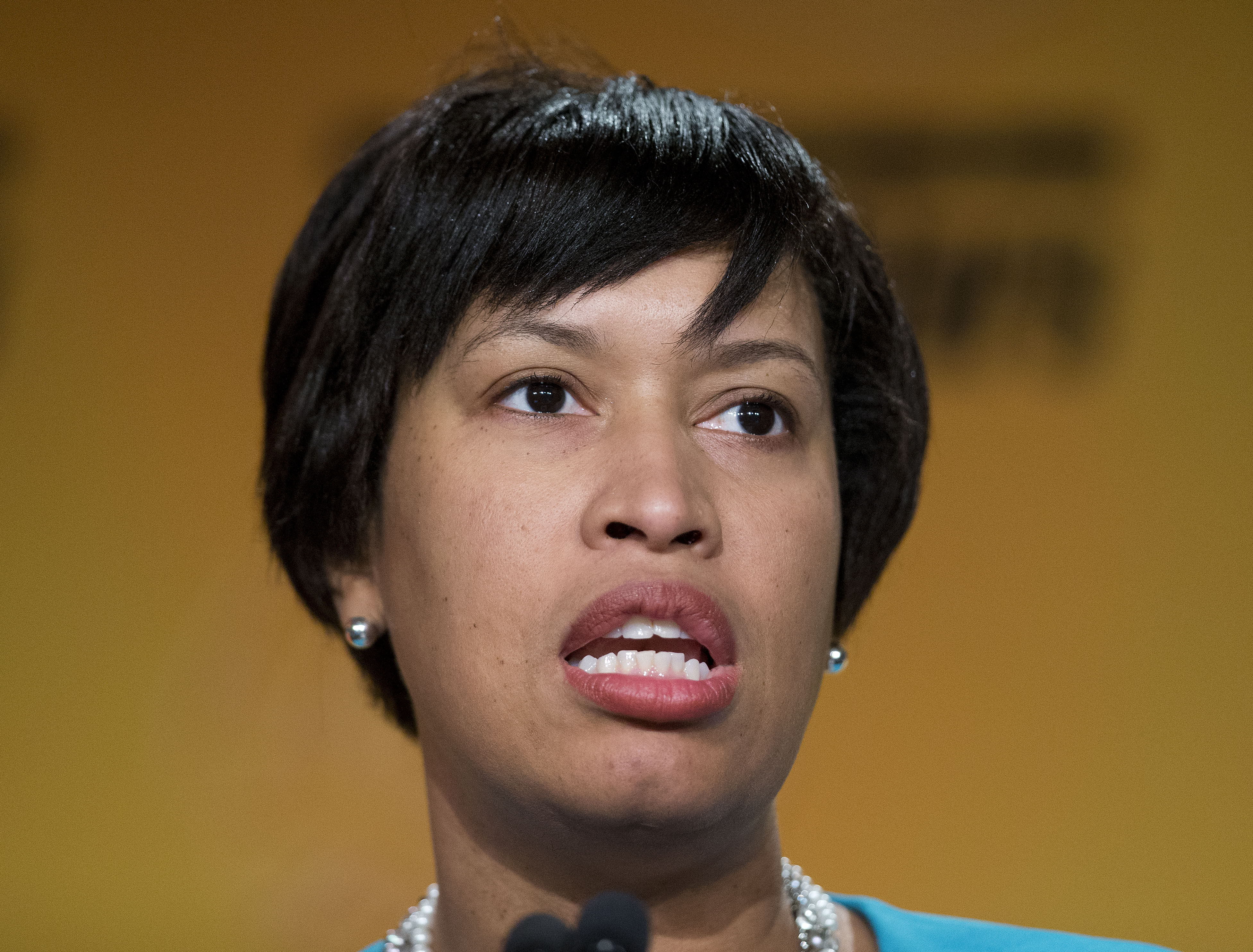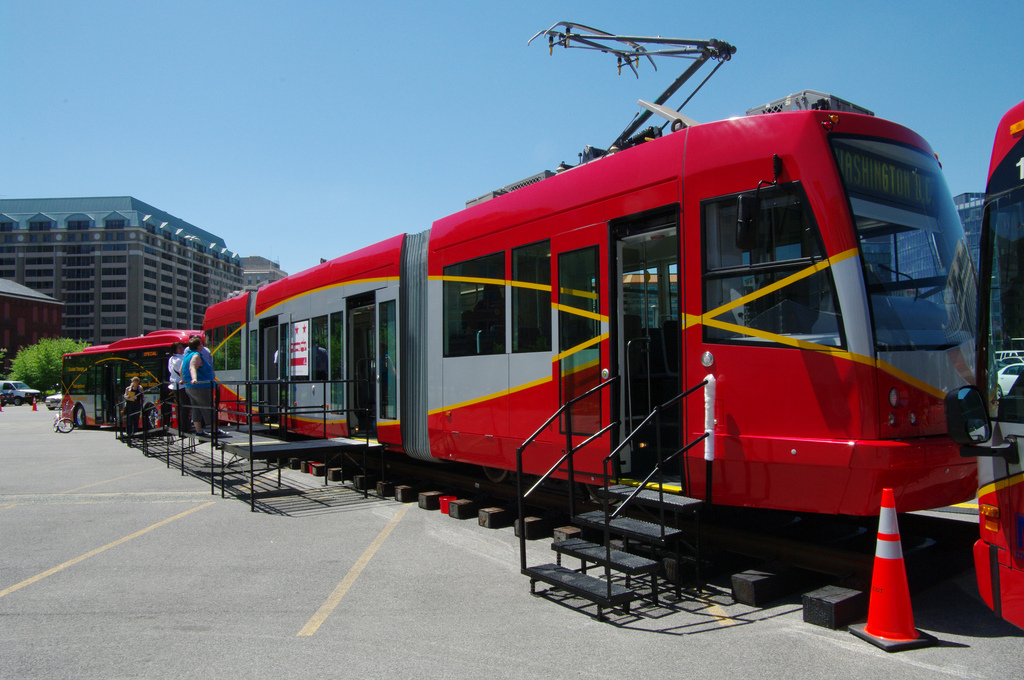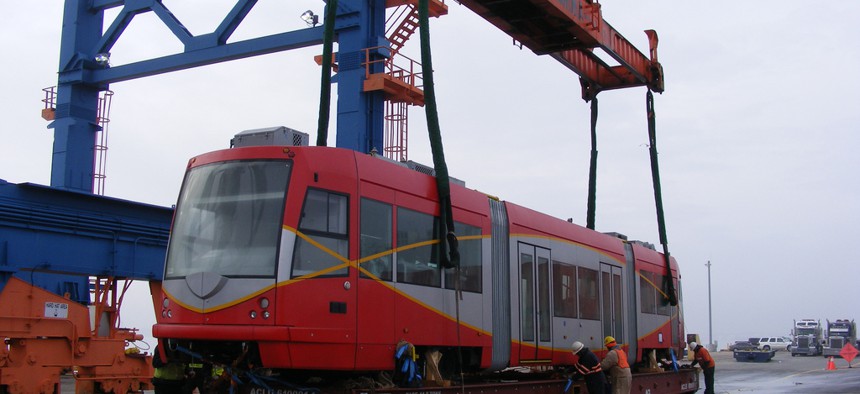Connecting state and local government leaders
America’s so-called ‘worst transit project’ could be scrapped inches from the finish line. Can the District of Columbia government salvage its streetcar line and its nearly $200 million investment?
WASHINGTON — District of Columbia officials might not realize it, but other major cities around the United States are watching how the local government in the nation’s capital deals with its streetcar debacle.
They’re waiting to see how the District government resolves the management problems that have plagued the delivery of the long-promised transit line that sits essentially complete but could be killed off inches from the finish line before any of the bold red streetcars transport a single passenger along the route.
If D.C. pulls the plug on its nearly $200 million investment and more than a decade’s worth of planning and construction, the District government will be “a laughingstock,” one municipal official on the West Coast told me last month.
Nobody really denies that the District government has done a poor job managing its streetcar project, which has stretched out over four mayoral administrations and many more local transportation directors.
“It’s a classic example of when everyone’s in charge, nobody’s in charge,” D.C. Councilmember Charles Allen, a streetcar supporter who represents the ward where the transit project has taken shape over the past decade, told me in an interview on Monday.

D.C. Mayor Muriel Bowser (Photo by Pablo Martinez Monsivais / AP Photo)
Earlier this year, Leif Dormsjo, the transportation director for new Mayor Muriel Bowser, ordered an intensive review of the streetcar project, its management and whether the line should be scrapped or can be salvaged. Dormsjo has been fairly tight lipped about the intensive review process, which has irked some transit advocates.
A lot is riding on the District’s next move on its troublesome 2.2 mile inaugural streetcar project. Hundreds of millions of dollars of private investment has been pumped into the streetcar corridor. Many people and businesses moved in along the route because the District government has long promised the transit project.
So what went wrong? It’s a complicated story that could be the subject of a public administration master’s thesis.
Back during the District of Columbia’s 2010 mayoral race, I asked then-D.C. Council Chairman Vincent Gray, who was seeking to unseat incumbent Mayor Adrian Fenty, whether he thought the D.C. government, which had big ambitions to build a streetcar network crisscrossing the city, was well suited to run its own transit agency.
In many U.S. cities, local public transit services are often run by independent, regional or state agencies. City hall officials and bureaucrats definitely play a role in how their local street networks are used or how transportation services and infrastructure are planned out, but the nuts and bolts of transit operations are often managed independently or semi-independently of a local transportation department.
The District Department of Transportation, through a public-private partnership, manages the D.C. Circulator, a popular network of higher-frequency, limited-stop bus routes connecting key locations, neighborhoods and commercial corridors in the nation’s capital. The Circulator was then and remains separate from the larger, regional Metrobus system run by the Washington Metropolitan Area Transit Authority, which also oversees the regional Metrorail network.
My question to Gray was essentially this: Can DDOT effectively manage day-to-day streetcar and Circulator bus operations as it plans and executes long-range expansions of the streetcar and Circulator networks or should it look to have WMATA or another entity to manage those local transit services?
The venue for this question was during a Washington City Paper mayoral endorsement interview when I worked at the alt-weekly as deputy managing editor. Gray was in campaign mode, and was careful not to say anything too specific or controversial through the course of the interview.
The streetcar project had already been a piping hot potato for Gray that campaign season.

Former D.C. Mayor Vincent Gray (Image by Rena Schild / Shutterstock.com)
One notable flashpoint from May of that year, as I noted for City Paper at the time: Transit advocates flooded Gray’s office with furious phone calls, emails and social media attention when news broke that he had unexpectedly slashed streetcar funding during late-night closed-door D.C. Council budget discussions. The corridor outside his office in the Wilson Building, D.C.’s seat of local government, was packed with highly vocal and unhappy transit supporters. Gray, within a few hours, had backed down and restored funding for the streetcar project.
Gray’s answer to my question during the City Paper endorsement interview was fairly safe: If elected, his administration would study the various options for how to best manage the city’s transit networks. (In the context of the 2010 mayoral election, Gray’s “deliberative” cool-tempered management approach stood in stark contrast to Fenty’s reputation for being a hard-charging, aggressive mayoral manager.)
Gray said that a multi-jurisdictional agency like WMATA might not be the best entity to run transit services designed with local District of Columbia residents in mind, not commuters from Maryland and Virginia heading in and out of the nation’s capital.
Gray said:
But I’m not convinced at this stage—I’m not saying I won’t be—I’m not convinced at this stage that putting something that is wholly dedicated to the District of Columbia under [WMATA] is absolutely the right way to go . . . So, I don’t think there is a clear answer to this at this stage but the pathway to an answer is to sit down, make sure we know where we’re going with our own transit system in this city and then talk about a governance model that works best for us.
Chairman Gray, who would ultimately defeat Fenty that year to become Mayor Gray and later lose re-election in 2014 under a cloud of never-ending scandal from his 2010 campaign, had a valid point. Regional agencies like WMATA—which was already in crisis mode dealing with the aftermath and the federal-led investigation of the deadly 2009 Red Line train collision—can get bogged down in multi-jurisdictional budgetary and governance politics.
But flash forward to 2015 with the completed streetcar yet to offer passenger service, and re-ask the basic question I asked Gray in five years ago: Should the District Department of Transportation be running day-to-day streetcar operations?
In the long run, Gray’s administration never intended for DDOT to be the day-to-day operator of the streetcar line. In October 2014, the administration announced a list of potential streetcar “builder-operators” for the next phases of streetcar expansion through “a program and contracting mechanism that leverages private-sector expertise for efficient and innovative delivery of the design, build, operations, and maintenance (DBOM) of the Streetcar and Circulator bus systems in the District.”
Perhaps a better question to ask Gray, considering the project’s current limbo, would have been: Can DDOT actually finish the streetcar project?
The agency has been struggling to tie up the loose ends on the yet-to-open streetcar line along H Street NE and Benning Road, which has sparked plenty of Tennessee Williams-inspired headlines like “It Might Be Desired, But In D.C. It’s a Streetcar Named Delay.”
Locally, the District’s management of the streetcar project is the butt of jokes, especially after Gray promised numerous times to have a functioning streetcar line during his mayoral tenure and kept on moving the goalposts down the field.
Supporters of the streetcar, not surprisingly, have been disheartened and frustrated.
On Monday, when I told Allen that municipalities on the other side of the country were shocked by local government management blunders in the nation’s capital, he said that District officials shouldn’t be making a decision on whether to save the streetcar line because of municipal peer pressure or concerns about the D.C. government’s reputation.
That reputation has already sustained plenty of blows during the course of this tortured saga, where observers have been treated to stories about how DDOT failed to “to establish common rules of the road” for how the streetcar operates with existing Metrobus service or figure out how to manage fare collection.
“I think the DDOT director is doing the right thing taking a sober look at the streetcar,” Allen, who feels confident that the transit project will survive, told me. “I think we owe it to a lot of people to get it right.”
But the nearly-to-the-finish-line streetcar line, which has been derided as “the worst transit project in America,” could be soon dead, killed off by the hands of the D.C. government.

A D.C. streetcar at a showcase event in 2009 (Image via DDOT)
Inches From the Finish Line
D.C.’s red streetcars—red is color District leaders picked to brand its transportation infrastructure, including the successful Capital Bikeshare system, Circulator buses and taxicabs—have been traveling the route as part of pre-opening service testing.
The streetcars have not yet received the regulatory green light for passenger service. There was a flash fire atop one streetcar vehicle that prompted an investigation. Improperly parked cars have delayed streetcar vehicles and necessitated aggressive parking enforcement.
There have been headline-grabbing car-streetcar accidents, though that is not uncommon with new streetcar projects, especially those that operate with mixed traffic instead of those that operate on their own rights of way. (The streetcar operates in mixed traffic along H Street before traveling into a track right of way in the median of Benning Road.)
The American Public Transit Association, at the Bowser administration’s request, has been peer reviewing D.C.’s streetcar program and unresolved issues that the D.C. government needs to sort out before getting the official green light.
Will that report be a preview to an eventual post mortem inquiry on an essentially completed but killed-off streetcar line? Or can the D.C. government sort out the remaining problems and salvage the project?
While the future of the streetcar project hangs in the balance, the reputation of the District government is also in a vulnerable spot. The Dutch Embassy in Washington, in a quirky unrelated diplomatic spat with current Bowser, recently skewered D.C.’s “almost” streetcar line.
In this case, Bowser’s Dutch spat is just a minor sideshow. What’s not minor is the anger from developers and business interests, plus plenty of residents, who have been promised a streetcar line for years and have invested hundreds of millions of dollars based on that promise.
Dissecting a Problematic Process
Thus far, D.C.’s incredibly bumpy experience delivering its long-promised streetcar project has given public administration academics plenty of teachable moments that any municipality figuring out how to successfully deliver a complicated infrastructure investment could learn from.
So what has gone wrong with D.C.’s execution of its streetcar project, which has now stretched out over four mayoral administrations?
Here are some of the dynamics at play:
- The majority of the streetcar’s physical infrastructure—the tracks, stations and upgraded streetscaping—was completed years ago. The streetcar vehicles were also purchased years ago—prompting occasional stories in the local media checking in on the D.C.-owned vehicles, which were periodically taken out of storage in the Czech Republic to make sure they were still in good working condition. Those first streetcars arrived in the D.C. area in 2009, were put in storage and brought out for DDOT special events promoting D.C.’s streetcar efforts. Boiling it all down, D.C. purchased the streetcar vehicles before having any tracks. And if D.C. scraps the streetcar program, it will then have a handful of streetcar vehicles and track and station infrastructure sitting unused.
- Later, the D.C. government faced a protest from the Czech manufacturer from the initial streetcar vehicle purchase that an Oregon company that won a D.C. contract to build additional streetcar vehicles was ineligible to win the contract. Contracting disputes aren’t unusual with infrastructure projects but they can cause delays.
- The streetcar line’s infrastructure was largely constructed before plans were finalized for a streetcar maintenance facility along the route. The location of that facility faced some community opposition, which delayed construction until 2013 and increased costs in the process.
- The D.C. government was blocked from using an unused tunnel beneath the Union Station rail yard, which DDOT had hoped to use as terminus to connect local streetcar passengers directly with Metrorail, intercity and commuter rail services. The streetcar line, as constructed, terminates on a street viaduct that crosses over the rail yard and the transfer to other transportation services necessitates a walk through a parking garage. That viaduct is nearing the end of its useful lifespan and will need to be replaced in a few years. Union Station itself, and the air rights over its rail yard, are slated, eventually, for major improvements and redevelopment. How the streetcar, which would eventually continue west through downtown to Georgetown, exactly fits into those long-term plans is unclear.
- Overheard wires, which power most streetcar systems around the world, are prohibited in D.C.’s central core to preserve aesthetic appeal along key corridors, thoroughfares and vistas. The D.C. government pushed legislation granting an overhead wire exception for H Street NE and Benning Road in order for the streetcar project to proceed. D.C.’s former streetcar network, which ceased operations in the early 1960s, relied on an underground conduit between the tracks to supply the electricity needed to power the streetcar vehicles. But such a system wouldn’t be feasible today. There are a handful of modern wireless streetcar systems that partially rely on battery power. Even if D.C. manages to salvage its streetcar program, expansion of D.C.’s streetcar network would be dependent on the ability of wireless streetcar technology to effectively power vehicles traveling over longer stretches of track where overhead wiring would be banned by statute.
But most importantly, perhaps, is the fact that it’s been hard to figure out who has been exactly in charge of D.C.’s streetcar project at DDOT, which has experienced what’s been described as a major agency brain drain in recent years.
Allen, who served as chief of staff for then-Councilmember Tommy Wells for many years before winning his ward seat last year, told me that under the Fenty administration, then-DDOT Director Gabe Klein had a streetcar point person.
But in the last year or so of the Gray administration, just as delays started to mount and red flags emerged, “nobody was the point person at DDOT” on the streetcar, Allen said.
But should deep management problems delivering the project sink D.C.’s expensive investment in the streetcar?
Clinton Yates, a Washington Post local columnist (and my former colleague at The Washington Post’s Express newspaper) wrote last week the whole project should be scuttled “immediately”:
If a transit operation that appeals mainly to smart-growth geeks and nostalgia enthusiasts can’t make it to fruition under three different mayors, it’s time to cut our losses.
That may be both a short-sighted view and a blunt, needed assessment. But Yates seems to ignore all the business and development interests who are counting on the streetcar and lumps them in with the “smart-growth geeks and nostalgia enthusiasts” who have supported the project for years.
Just before my meeting with Allen, representatives from one of the major developers with big plans for H Street NE had met with him to raise their concerns about the potential death of the streetcar project. Allen, of course, won’t make the final decision whether the streetcar will live or die. The current mayor and her administration will.
“The business community needs to talk to the mayor and tell her,” Allen told me, that killing off this project sends a terrible economic development message to businesses interested in investing in the local economy.
And that leads to few more important questions that are larger than this problematic streetcar itself and get to the heart of municipal governance.
What does it say if a local government spends nearly $200 million and devotes so much time and energy on a project only to kill it off at the last moment with the finish line just steps away? Is that worse than all of the accumulated problems and headaches to date?
How would such a high-profile management failure of local government reverberate? Would it undermine municipal ambitions to tackle future complex civic improvements? Perhaps. Would it cause citizens’ confidence in their local government to take a hit? Yes, and in the case of D.C., that’s already happened.
Allen is right that the District government should make its streetcar decision based on the best interests for the city and brush off any snide comments about D.C. becoming a municipal “laughingstock.”
But the mayor should know that there’s a whole lot more at stake than just the streetcar and plenty of people who live outside of the D.C. line are watching the next move.
Michael Grass is Executive Editor of Route Fifty, the Government Executive Media Group’s soon-to-launch digital news publication about state, county and municipal government and currently oversees GovExec.com’s State & Local news operations. (Sign up for Route Fifty updates here.) In 2002, Grass worked as a consultant at the Federal Transit Administration, and previously wrote about the D.C. government and D.C.-area transportation issues at DCist.com, Washington City Paper and at The Washington Post’s Express newspaper.




